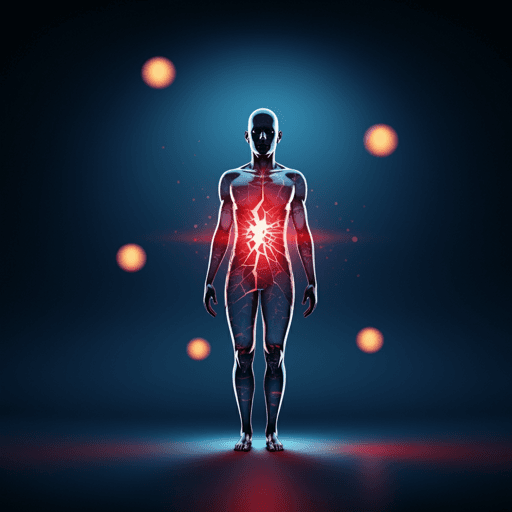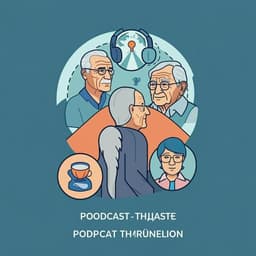
Psychology
The association between loneliness and pain, and the role of physical health and distress: an analysis in 139 countries
L. Macchia and A. Fett
Loneliness is strongly linked to higher odds of physical pain, health problems, and psychological distress across 256,760 people in 139 countries, with psychological distress explaining much of the connection. Research conducted by the authors Lucía Macchia and Anne-Kathrin Fett uses 2023–2024 Gallup World Poll data to reveal cross-cultural variation and calls for longitudinal study.
~3 min • Beginner • English
Introduction
Loneliness is an aversive state related to lack of belonging or a perceived discrepancy between desired and actual social relationships. It is associated with poor physical and mental health, including elevated risks for cardiovascular disease, diabetes, stroke, depression, anxiety, psychosis, suicidal ideation, and mortality. Loneliness poses a substantial burden on individuals and healthcare systems and is recognized as a global health priority by WHO and governments. Beyond psychological correlates, loneliness has been linked to a higher likelihood of experiencing physical pain. The biopsychosocial model views pain as influenced by psychological processes and social context; perceptions of loneliness, available social support, and opportunities to meet people may all be relevant. Loneliness, pain, and negative affect tend to cluster; negative affect may reduce pain coping and increase loneliness, suggesting psychological distress could partly account for loneliness–pain associations. Loneliness has often been viewed as an issue of old age, but evidence shows heterogeneity, with peaks in young adulthood and the oldest old. Health and pain are age-related, and it is plausible that associations between loneliness and pain change with age, although this has not been comprehensively investigated. Prior work finds limited evidence for sex differences in some groups (e.g., adolescents, older adults), but gaps remain across the adult lifespan; biological, social, and economic factors may contribute to sex-specific patterns. The present cross-sectional analysis uses nationally representative data from the 2023 and 2024 Gallup World Poll (139 countries; >250,000 respondents) to examine associations between loneliness and pain across sexes and the adult lifespan, and to assess the extent to which health problems and psychological distress account for this association, while considering social support, opportunities to meet people, and key demographics. Exploratory cross-cultural analyses are also reported. While causal inference is not possible with cross-sectional data, these analyses address important knowledge gaps and can inform future longitudinal and experimental research.
Literature Review
Prior literature defines loneliness as a perceived deficiency in social connection and links it to adverse physical and mental health outcomes, including cardiometabolic disease, psychiatric disorders, and increased mortality. Conceptual models of pain (biopsychosocial) emphasize psychological and contextual contributors, aligning with evidence that loneliness relates to both psychological pain and physical pain experiences. Negative affect (stress, sadness, worry, anger) clusters with loneliness and pain and may undermine coping. Across the lifespan, loneliness exhibits heterogeneous patterns, with higher levels in young adults and the oldest old compared to midlife; age-specific social demands and health-related limitations may shape these patterns. Evidence for sex differences in loneliness–pain links is mixed in specific subgroups, but broader adult samples remain underexplored; potential mechanisms include higher prevalence of certain health conditions in females and socio-economic inequalities. Prior work indicates that physical health and social factors (support, opportunities for contact) may contribute to the loneliness–pain link, but the magnitude of these pathways relative to psychological distress remains unclear, motivating the current study.
Methodology
Design and data source: Cross-sectional analyses using Gallup World Poll (GWP) data from 2023 and 2024. The GWP is a nationally representative survey conducted annually in up to 168 countries/territories since 2005, using random-digit dialing in high telephone coverage regions and face-to-face interviews where coverage is lower. Gallup applies weights to adjust for selection probabilities, nonresponse, and to match national demographics. The loneliness item is available only in 2023–2024; thus, the analytic sample comprises 256,760 respondents aged 15–100 from 139 countries (approximately 53% female; mean age 42.9 years, SD 18.07).
Measures:
- Dependent variables:
• Physical pain: Binary (yes/no) response to experiencing physical pain “a lot of the day yesterday.” Used as 0/1 in logistic regressions. Prevalence: 34.5%.
• Health problems: Binary (yes/no) response to having health problems preventing normal age-typical activities. Used as 0/1 in logistic regressions. Prevalence: 26.4%.
• Distress: Continuous index (0–1) averaging four binary items (sadness, anger, stress, worry) experienced “a lot of the day yesterday.” Mean 0.307.
- Main independent variables:
• Loneliness: Binary (yes/no) for feeling lonely “a lot of the day yesterday” (22.7% yes).
• Having relatives/friends to count on: Binary (yes/no) to having support in trouble (80.1% yes).
• Satisfaction with opportunities to meet people: Binary (satisfied/dissatisfied) with local opportunities to meet people and make friends (80.6% satisfied).
- Covariates: Age (and age squared), sex, education (elementary/secondary/tertiary), marital status (single, domestic partner, married, separated, divorced, widowed), employment status (full-time employee, full-time self-employed, part-time want FT, part-time do not want FT, unemployed, out of labor force), personal income (USD), number of children under 15 in the household.
Statistical analysis:
- For physical pain and health problems (binary outcomes): Binary logistic regressions.
- For distress (continuous 0–1): OLS regressions (linear probability framework for comparisons).
- All models include country and year fixed effects and account for having friends/relatives to count on, satisfaction with opportunities to meet people, and specified demographics (as applicable). Standard errors are clustered at the country-year level.
- Sequential models estimate the association of loneliness with each outcome, then adjust for social support/opportunity and demographics. Additional models adjust the loneliness–pain association for health problems (Table 5) and for distress (Table 6). Interaction models assess whether the loneliness–pain association varies by sex and by age (Table 7).
- Robustness: OLS models using continuous versions of pain and health problems and multilevel models with random intercepts for countries yielded similar conclusions (reported in the Supplementary Materials). Country-specific fully adjusted regressions are provided in the supplement (Tables S.24–S.26).
Key Findings
Sample characteristics and prevalence:
- In the full sample, 22.7% reported feeling lonely a lot the previous day; 34.5% experienced physical pain; 30.7% experienced distress; 26.4% reported health problems limiting day-to-day functioning.
- Lonely vs non-lonely: Lonely individuals were 22.8% more likely to report pain (52.2% vs 29.4%), 17.8% more likely to report health problems (40.2% vs 22.4%), and 29.4% more likely to report distress (53.4% vs 24.0%). They were less likely to have friends/relatives to count on (69.1% vs 83.4%) and to be satisfied with opportunities to meet people (71.9% vs 83.2%).
Associations of loneliness with outcomes (main models):
- Physical pain (Table 2): OR=2.404 (p<0.001) unadjusted; remains significant after adjustments including demographics, social support/opportunity, and country fixed effects: fully adjusted OR=2.128 (log OR 0.755, 95% CI [2.057, 2.201]). Demographics and social support/opportunity statistically accounted for 14% of the loneliness–pain association.
- Health problems (Table 3): OR=2.249 (p<0.001) unadjusted; fully adjusted OR=1.849 (log OR 0.615, 95% CI [1.789, 1.909]). Demographics and social support/opportunity accounted for 24.2% of the loneliness–health problems association.
- Distress (Table 4): Lonely individuals had higher distress (b=0.275 unadjusted; fully adjusted b=0.258, p<0.001). Demographics and social support/opportunity accounted for 6.18% of the loneliness–distress association.
Accounting for health problems and distress in the loneliness–pain link:
- Adjusting for health problems (Table 5): Loneliness–pain OR decreased from 2.404 (log OR 0.877) to 2.037 (log OR 0.711) when controlling for health problems, indicating health problems account for 18.9% of the association. Fully adjusted with all covariates: OR=1.931 (95% CI [1.867, 1.995]).
- Adjusting for distress (Table 6): Loneliness–pain OR decreased from 2.404 (log OR 0.877) to 1.418 (log OR 0.349) when controlling for distress, indicating distress accounts for 60.2% of the association. Fully adjusted with all covariates: OR=1.280 (95% CI [1.248, 1.312]).
Sex and age moderation (Table 7):
- Sex: Positive interaction between loneliness and female sex for pain (ORs 1.101 to 1.062 across models, all p≤0.05), indicating slightly stronger loneliness–pain associations in females.
- Age: Interactions between loneliness and age were statistically significant but very small or negligible; patterns were broadly similar across ages.
Cross-cultural variation:
- Fully adjusted, country-specific regressions showed that associations between loneliness and pain, health problems, and distress varied across countries (from near zero to medium), suggesting cultural influences. Some of the poorest countries showed higher rates, but patterns did not strictly follow economic classifications.
Discussion
The study addressed how loneliness relates to physical pain globally and the extent to which physical health problems and psychological distress account for this relationship across sexes and the adult lifespan. Loneliness was strongly associated with higher odds of pain, health problems, and distress. Accounting analyses indicated that psychological distress explained the largest proportion of the loneliness–pain association, whereas health problems and socio-demographic/social factors played smaller roles. These findings align with biopsychosocial models of pain, underscoring the central importance of affective and contextual processes. The associations were broadly consistent across age groups and slightly stronger for females than males, suggesting similar underlying mechanisms across the adult lifespan with modest sex-specific amplification. Cross-country heterogeneity indicates that cultural, social, and policy environments likely modify the observed relationships. Overall, the results highlight that loneliness, pain, and distress are tightly interlinked phenomena affecting large segments of the global population, emphasizing the need to integrate psychological and social dimensions into public health strategies.
Conclusion
This global analysis demonstrates that loneliness is associated with substantially higher odds of physical pain, even after controlling for health problems, psychological distress, social support/opportunities, and demographics. Psychological distress accounts for the largest share of this association, with physical health and socio-economic/social factors contributing to a lesser degree. The relationships are similar across the adult lifespan and slightly stronger in females, and they vary by country, pointing to cultural influences. These findings support multi-faceted approaches to address loneliness and its painful correlates, combining interventions that reduce distress and enhance coping with strategies that strengthen social connection and address socio-economic inequalities. Future research should employ longitudinal and experimental designs to establish causal pathways, examine mechanisms (e.g., affect regulation, sleep, neuroendocrine and immune processes), and evaluate culturally tailored interventions across diverse settings.
Limitations
- Cross-sectional design prevents causal inference about the directionality between loneliness, pain, health problems, and distress.
- Health problems were self-reported rather than clinician-diagnosed; lonely individuals might report more negatively on their health.
- The health problems question may lead respondents to normalize some issues by age, potentially underestimating true prevalence; wording may also capture mental as well as physical health problems, contributing to overlap with distress.
- Single-item measures for key constructs raise potential common-method bias; although common in large global surveys, they limit granularity.
- The loneliness item (“felt lonely a lot the previous day”) does not capture degrees or chronicity of loneliness, limiting nuanced analyses.
- While nationally representative, the study relies on self-reported experiences from different survey modes (phone vs face-to-face), and unmeasured confounders may remain despite extensive covariate adjustment and fixed effects.
- Country-level cultural and contextual factors were not explicitly modeled beyond fixed effects; observed cross-country variability suggests further contextual measurement is needed.
Related Publications
Explore these studies to deepen your understanding of the subject.







